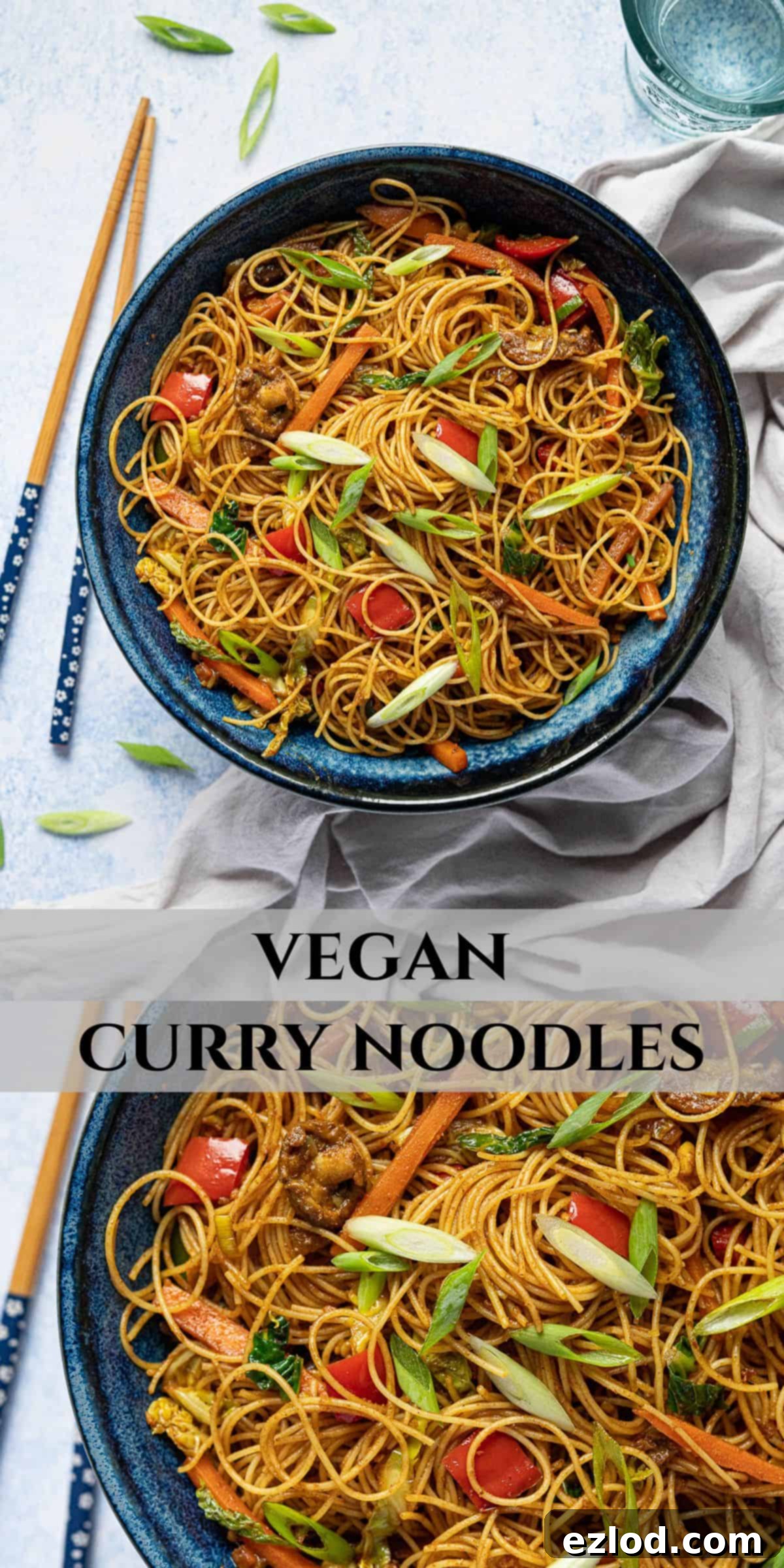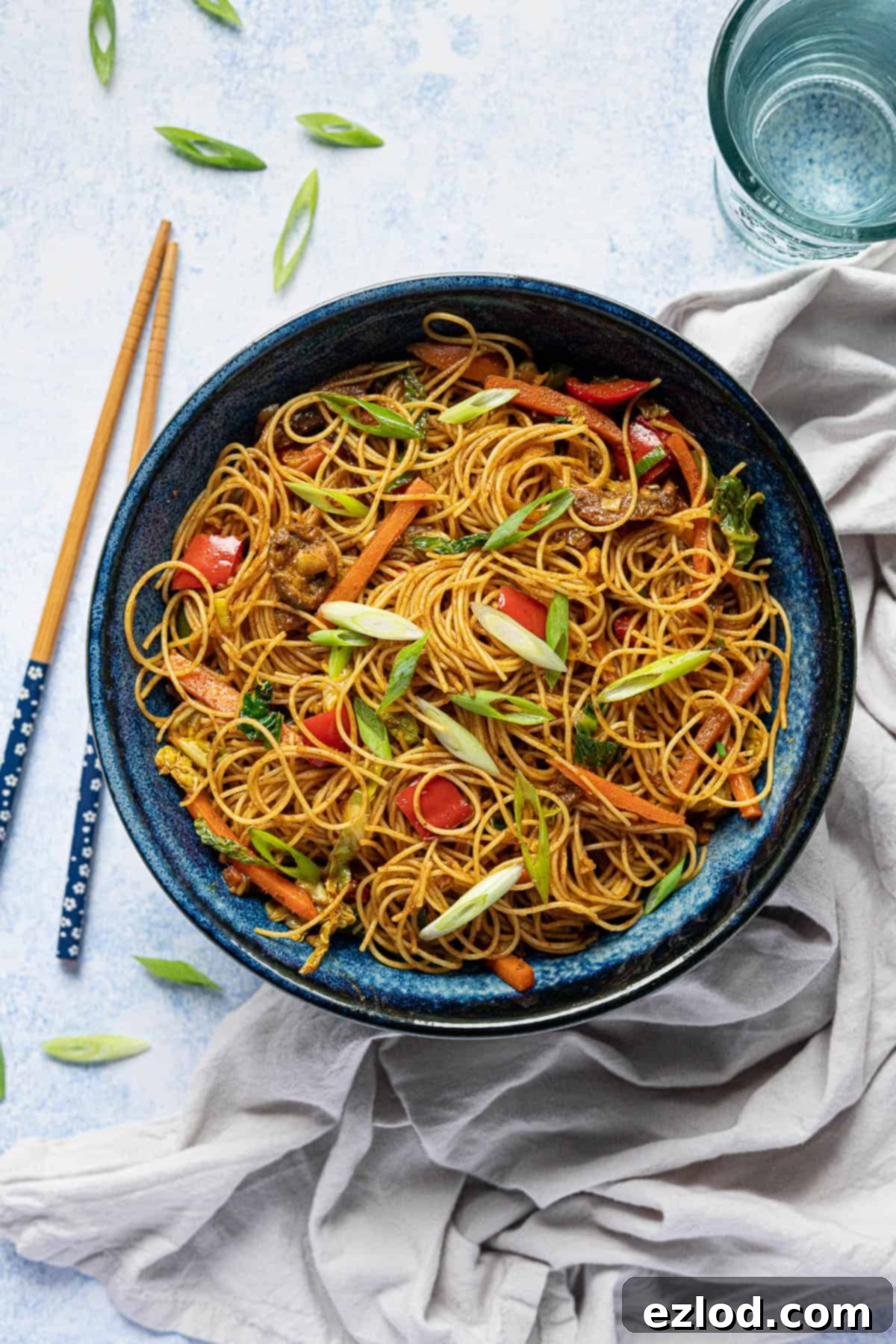Easy Vegan Curry Noodles Recipe: Quick, Flavorful & Plant-Based Perfection
Embark on a culinary journey with these incredibly easy vegan curry noodles! This delightful dish, brimming with vibrant vegetables and aromatic spices, offers a satisfying and flavorful experience, perfect as a standalone meal or a robust side dish. Inspired by the much-loved Singapore noodles, this plant-based version captures all the essence and zest while being entirely free from animal products. It’s not just a meal; it’s a testament to how quick, wholesome, and utterly delicious vegan cuisine can be, making it an ideal choice for busy weeknights or a comforting weekend treat.
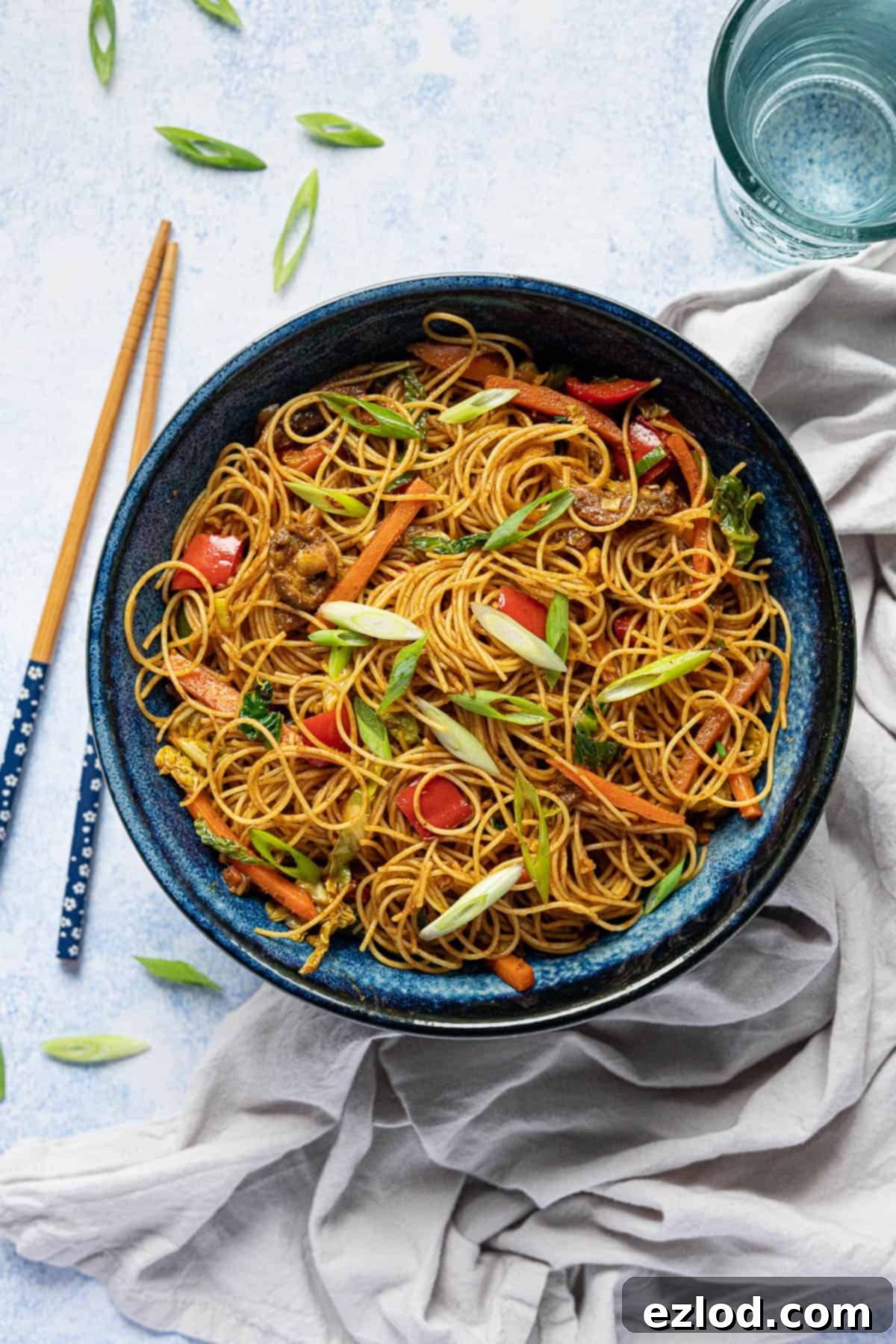
Our vegan curry noodles draw their inspiration from the iconic Singapore noodles, a globally cherished takeout classic renowned for its distinctive curry flavor and satisfying texture. Interestingly, despite its name, “Singapore noodles” are not a traditional dish found in Singapore itself. Culinary historians generally agree that this beloved stir-fry likely originated in the bustling kitchens of 1950s or 60s Hong Kong, a testament to its innovative fusion of flavors and techniques. The traditional version typically features stir-fried vermicelli rice noodles seasoned with curry powder, often including a medley of vegetables, scrambled eggs, succulent shrimp, and tender char siu pork.
For this recipe, we’ve thoughtfully adapted the original to create a completely vegan dish without compromising on taste or satisfaction. By omitting the meat, seafood, and egg, we’ve crafted a plant-based alternative that stands proudly on its own, delivering a rich, umami-packed flavor that’s both comforting and exciting. While it’s fantastic as a side, its robust nature also makes it a superb main course. For those seeking an extra protein boost, feel free to incorporate your favorite vegan meat substitutes, such as pan-fried tofu, tempeh, or seitan, transforming it into an even heartier, all-encompassing meal.
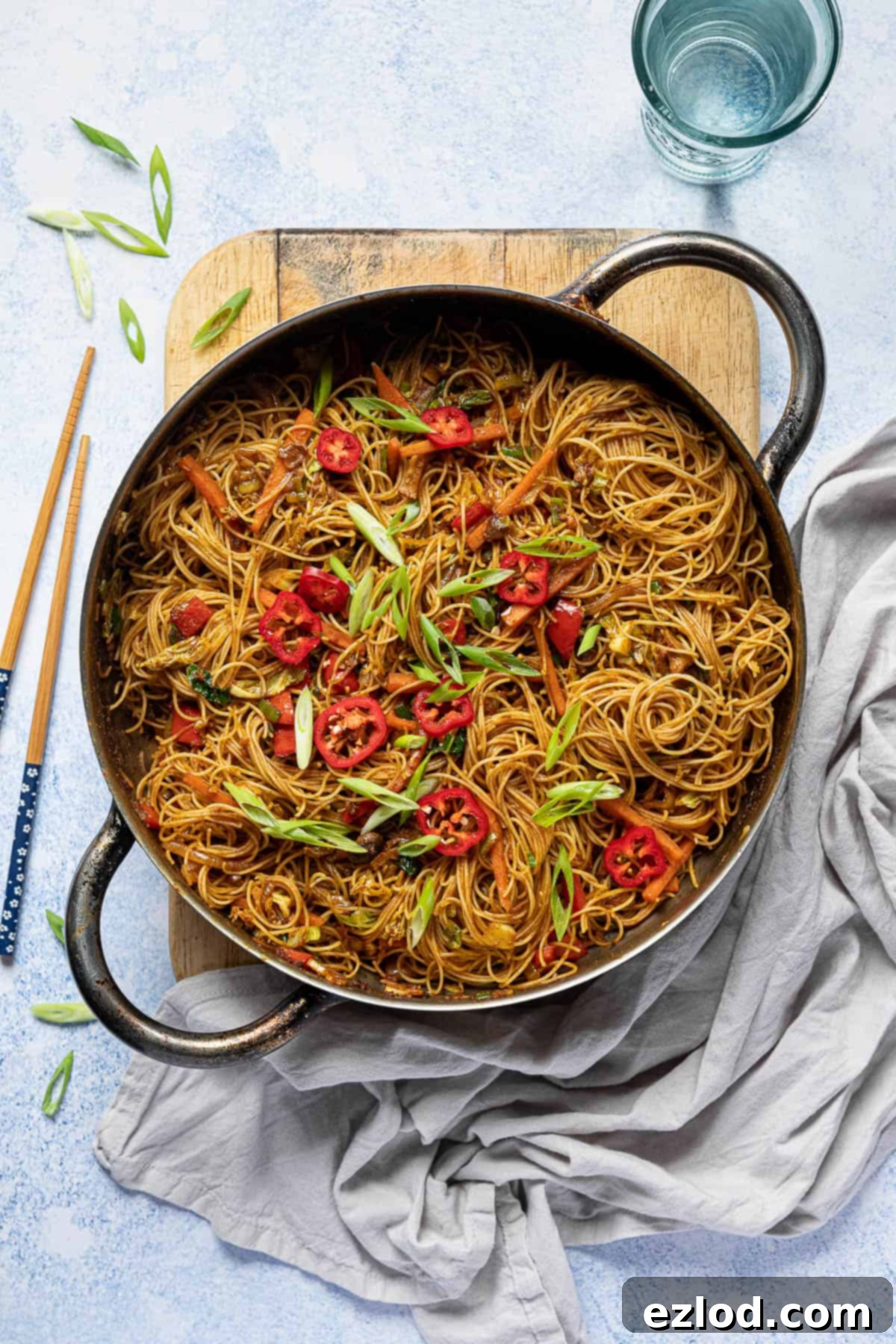
What You’ll Need to Create These Delicious Vegan Curry Noodles:
Crafting the perfect plate of curry noodles begins with selecting the right ingredients. Each component plays a vital role in building the layered flavors and textures that make this dish so irresistible.
- Rice Noodles: Vermicelli rice noodles are traditionally used for their delicate texture and ability to absorb flavors beautifully. However, don’t feel limited! This versatile seasoning blend works wonderfully with various types of noodles. You could opt for thicker rice noodles, ramen, or even regular wheat-based noodles, just be sure to check that they are egg-free for a truly vegan experience. Proper preparation according to package instructions is key to achieving that ideal al dente bite.
- Assorted Vegetables: Our recipe calls for a colorful mix of shredded cabbage, bell pepper, carrots, mushrooms, and onion. This combination offers a fantastic balance of crunch, sweetness, and earthy notes. The beauty of this dish lies in its flexibility; you can easily customize the vegetable selection based on what’s in season or what you have on hand. Bok choy, snap peas, broccoli florets, or even bean sprouts would make excellent additions, provided they are suitable for stir-frying and can cook relatively quickly.
- Curry Powder: The heart of the dish’s flavor profile! We typically use a mild curry powder to ensure broad appeal, but if you prefer a spicier kick, a medium or even hot curry powder would be excellent. For an extra vibrant yellow hue and a subtle boost of earthy flavor, we also recommend adding a little extra turmeric. This is optional but highly recommended for both color and its renowned health benefits.
- Soy Sauce: Light soy sauce is our preferred choice for its balanced saltiness and umami without overpowering the other flavors. If you opt for dark soy sauce, which is thicker and sweeter, you might want to use a slightly reduced amount to maintain the desired flavor balance. For a gluten-free version, tamari is an excellent substitute that delivers the same depth of flavor.
- Toasted Sesame Oil: This ingredient is a game-changer! Toasted sesame oil is incredibly fragrant and adds a deep, nutty, and distinctly Asian-inspired aroma and flavor to the noodles. A little goes a long way in elevating the overall taste profile.
- MSG (Monosodium Glutamate): While optional, MSG is a secret weapon for boosting the savory, umami richness of this dish. It truly enhances the overall flavor experience, making it taste incredibly satisfying and moreish. If you’re hesitant to use MSG, don’t worry, the dish will still be delicious. However, for maximum flavor depth, we highly recommend trying it.
- White Pepper: Often overlooked, white pepper possesses a unique, pungent, and slightly earthy flavor that is distinct from black pepper. It adds a subtle but important layer of warmth and a gentle kick without being overtly spicy. Use sparingly, as its flavor is quite potent.
- Fresh Aromatics: Fresh garlic, ginger, and spring onions (scallions) form the aromatic foundation of this stir-fry. Grated ginger provides a spicy, zesty freshness, while crushed garlic offers pungent depth. Spring onions are used both in the stir-fry and as a garnish, adding a mild oniony bite and a pop of color. These ingredients are essential for building a complex and authentic flavor base.
Your Step-by-Step Guide to Making Perfect Vegan Curry Noodles:
(For precise measurements and detailed instructions, please refer to the comprehensive recipe card located at the very bottom of this page.)
Prepping all your ingredients before you begin cooking is the golden rule for any stir-fry. This “mise en place” ensures a smooth, fast-paced cooking process, essential for achieving perfectly cooked noodles and crisp-tender vegetables.
- Prepare the Flavorful Sauce: In a small bowl or jug, combine the light soy sauce, fragrant toasted sesame oil, freshly grated ginger, crushed garlic, mild curry powder, turmeric (if using for extra color), MSG (if desired), and a pinch of white pepper. Whisk all these ingredients together thoroughly until they are well combined and the curry powder has dissolved into a smooth, aromatic sauce. Set this aside, as it will be added towards the end of the cooking process.
- Chop the Vegetables: Begin by peeling and thinly slicing your onion. Cut the bell pepper into thin strips or bite-sized pieces. Slice the mushrooms and carrot into similar, manageable pieces to ensure even cooking. Finally, shred the savoy cabbage and thinly slice the spring onions (scallions), reserving a small amount for garnish if desired. Having all your vegetables prepped and ready will make the stir-frying process seamless.
- Cook the Noodles: Follow the package instructions carefully for your chosen rice vermicelli or other noodles. Generally, this involves soaking them in hot water or boiling them for a few minutes until they are tender but still retain a slight chew (al dente). Once cooked, drain them thoroughly and rinse with cold water to prevent them from sticking together. A well-drained noodle is crucial for a non-soggy stir-fry.
- Stir-Fry the Vegetables: Heat 1 tablespoon of cooking oil in a large wok or a spacious frying pan over a medium-high heat. Once the oil is shimmering, add the sliced onion and stir-fry for about 2 minutes until it starts to soften and turn translucent. Next, add the remaining hardier vegetables (bell pepper, mushrooms, carrot, and cabbage). Increase the heat to high and continue to stir-fry for approximately 3 minutes, or until the vegetables are slightly softened but still retain a pleasant crunch. Avoid overcrowding the pan, as this can steam the vegetables instead of stir-frying them.
- Combine and Finish: Pour the prepared curry sauce over the stir-fried vegetables and add the sliced spring onions. Cook for another couple of minutes, stirring to ensure the sauce coats all the vegetables evenly and its aromas are fully released. Finally, add the thoroughly drained noodles to the pan. Using tongs or two spatulas, toss the noodles vigorously with the vegetables and sauce until they are completely coated and heated through. Continue to stir constantly for about 2-3 more minutes to allow the flavors to meld and the noodles to lightly caramelize.
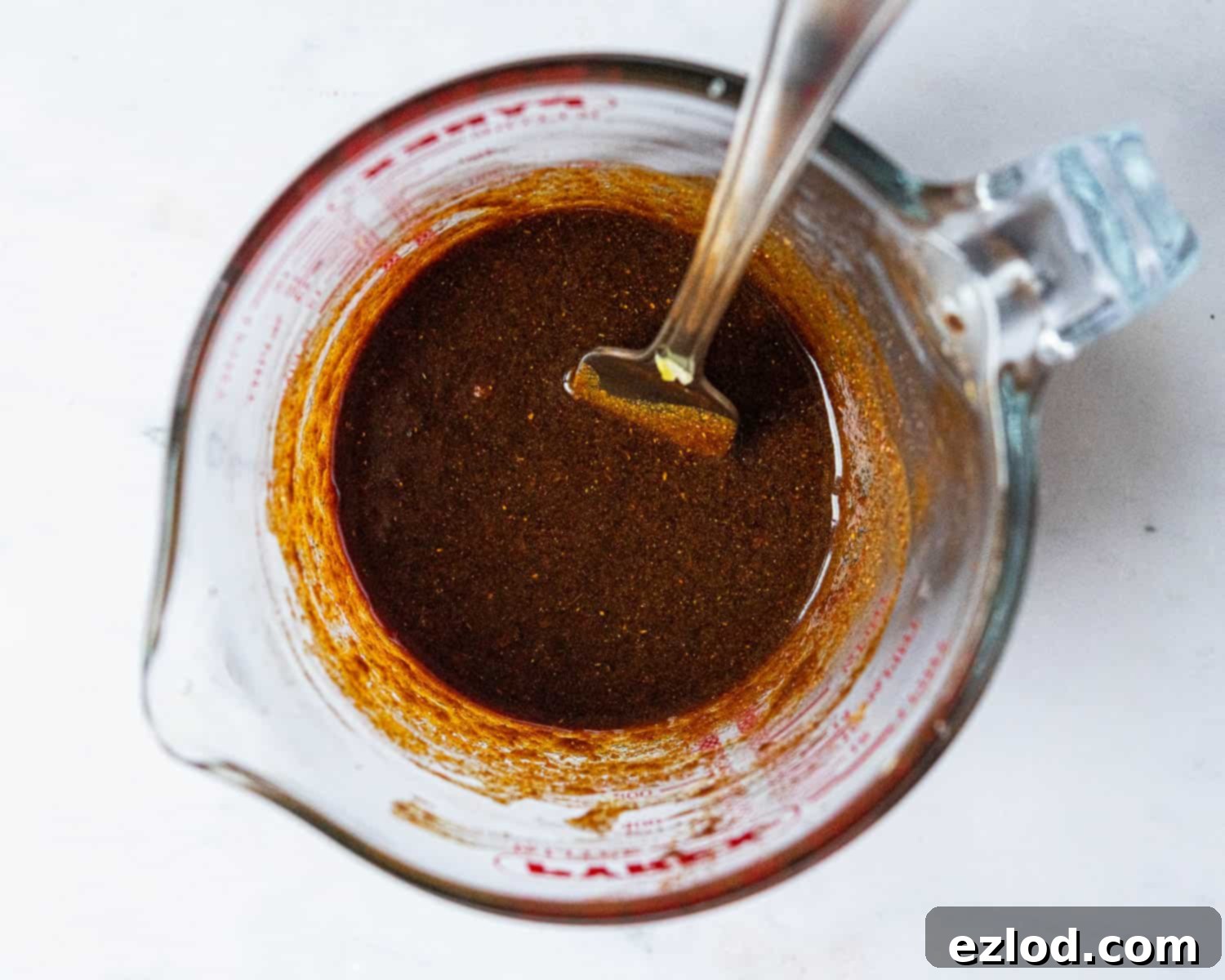
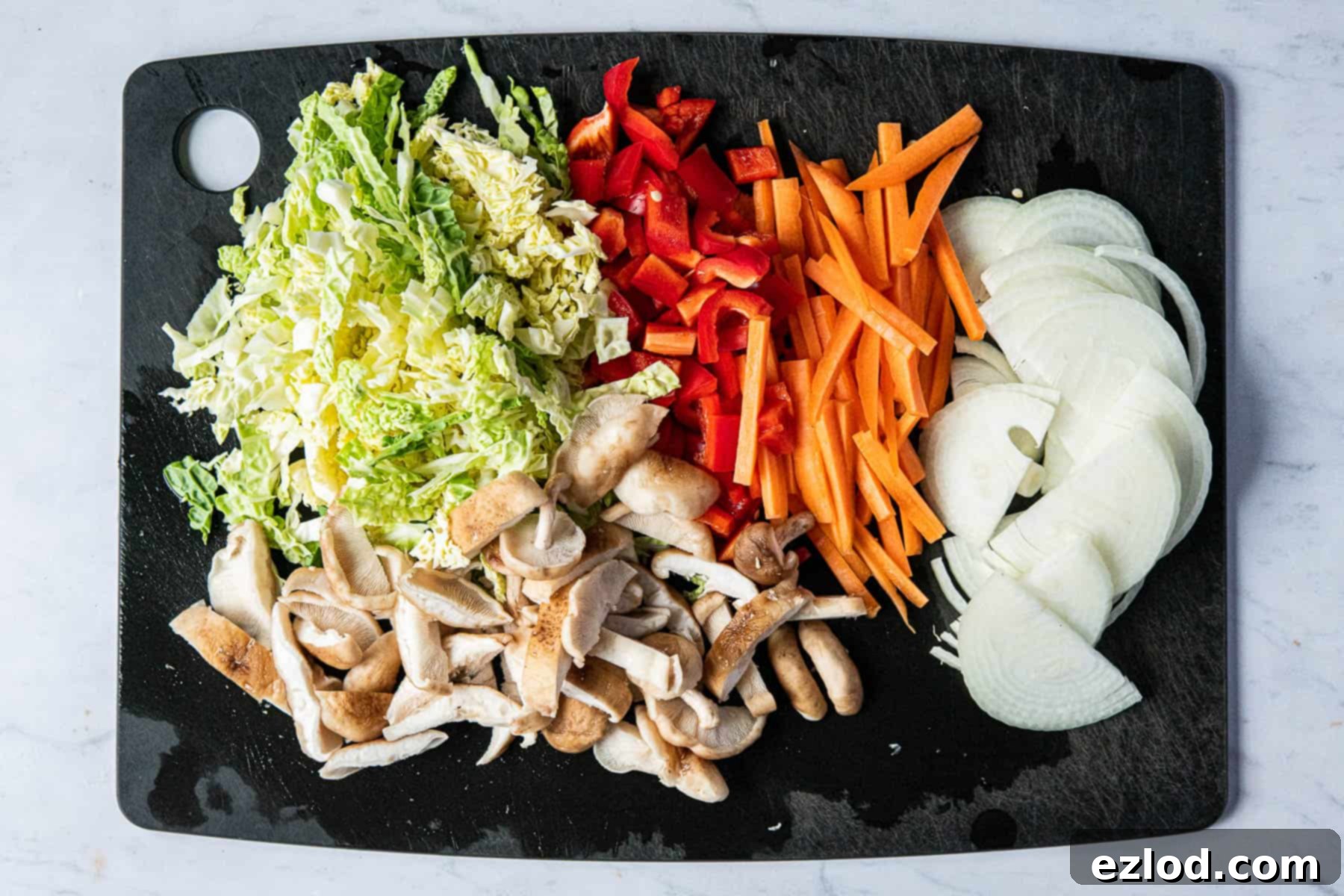
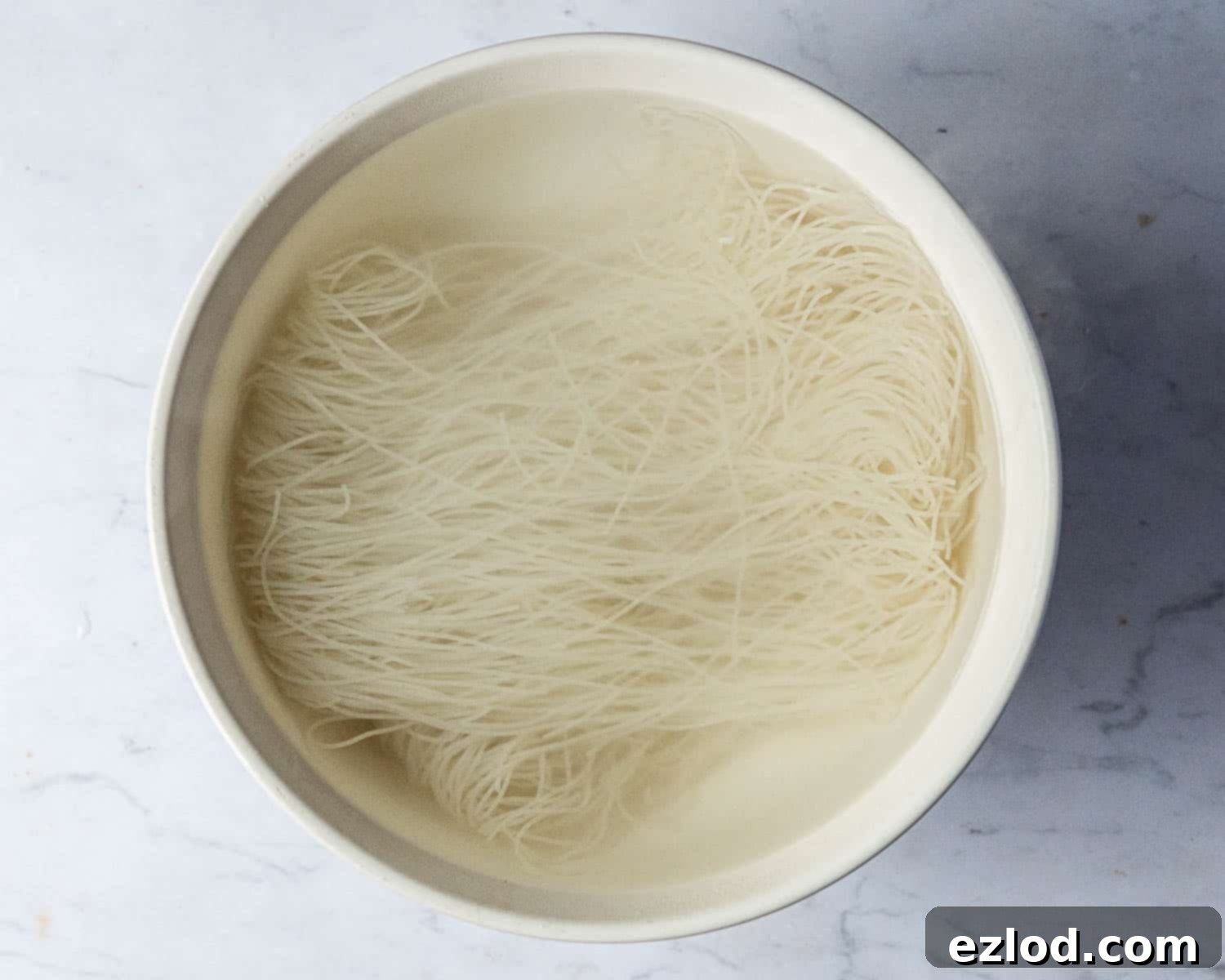
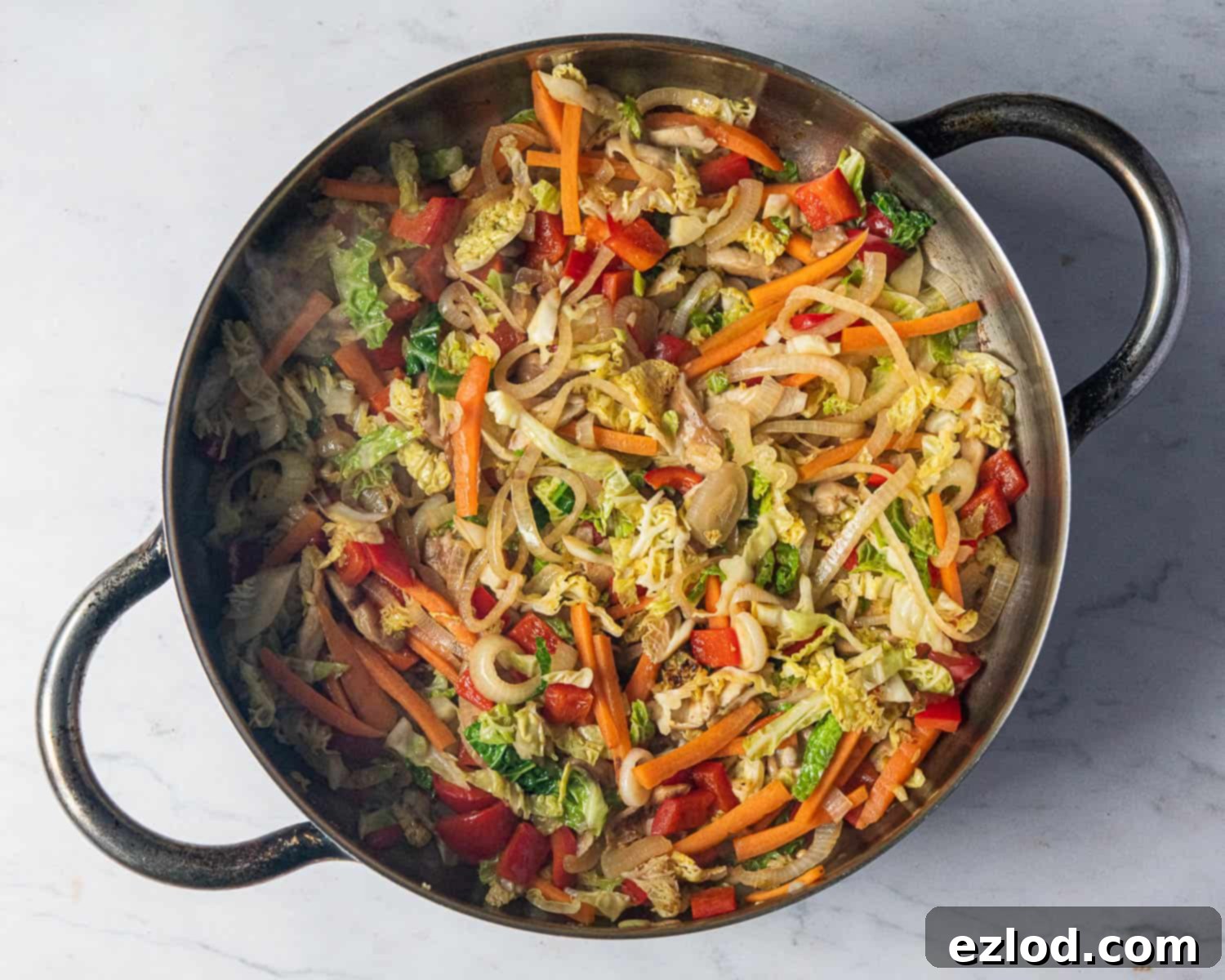
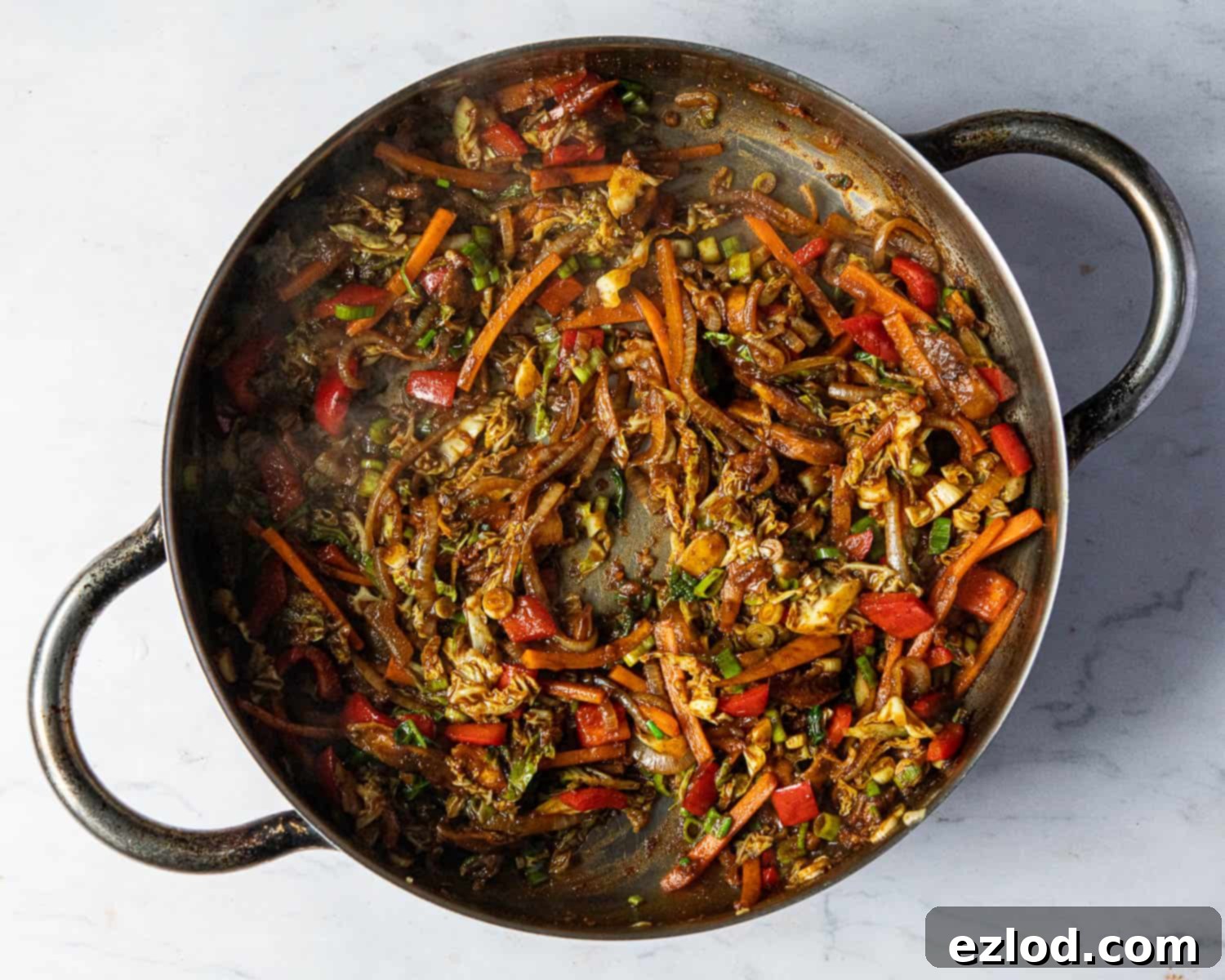
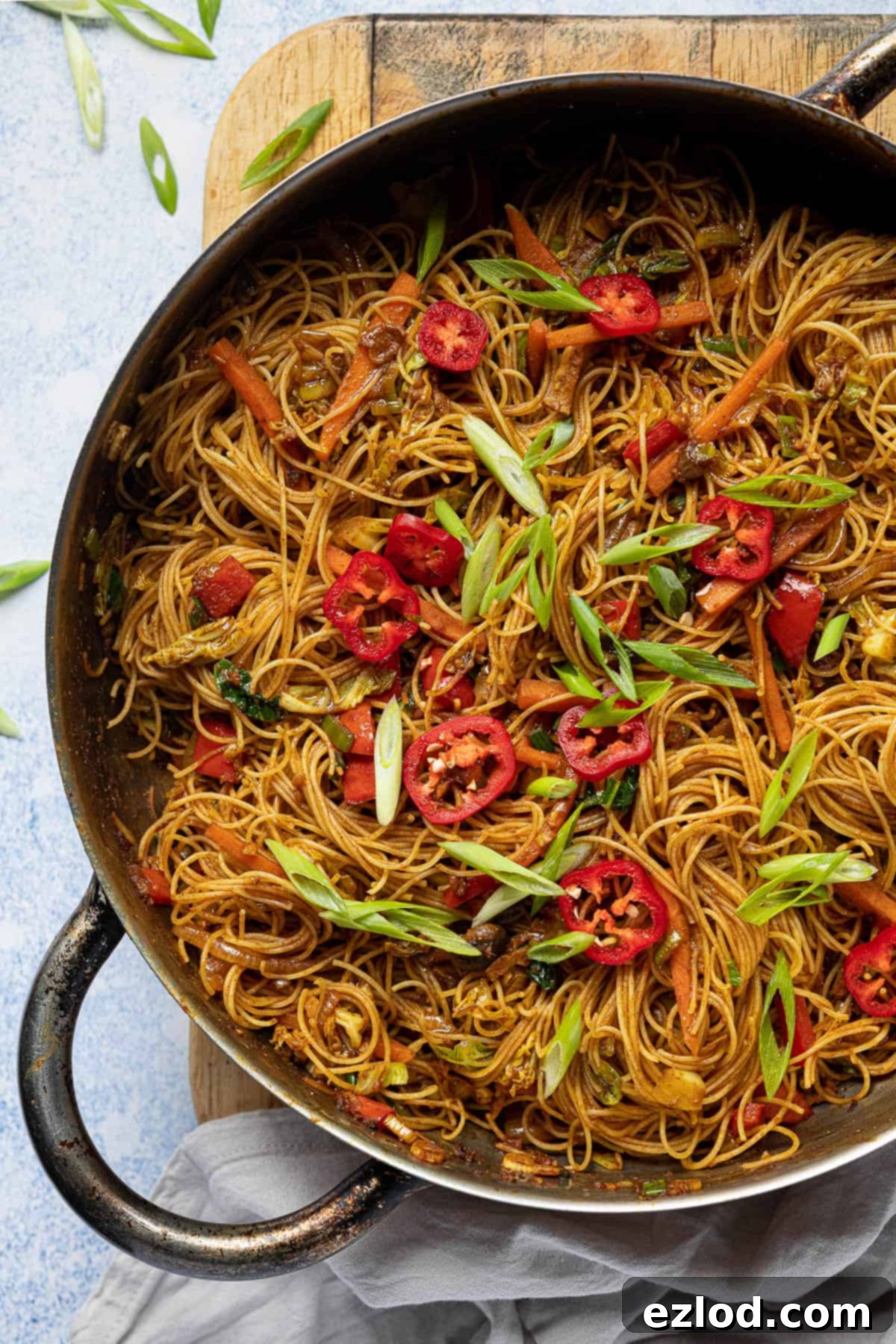
Expert Tips & Versatile Substitutions for Your Vegan Curry Noodles:
Elevate your curry noodle experience with these handy tips and creative substitutions:
- Embrace the Umami of MSG: As mentioned, MSG truly amplifies the savory, umami notes in this dish, taking it from delicious to extraordinary. If you can, we strongly recommend including it. If you prefer not to use MSG, you can still achieve a good umami boost by adding a dash of mushroom powder, a tablespoon of nutritional yeast, or even a splash of vegan Worcestershire sauce to your sauce mix.
- Mastering Mise en Place: For any stir-fry, having all your ingredients prepped, chopped, and measured before you even turn on the stove is paramount. Stir-frying is a fast-paced cooking method, and you won’t have time to chop while ingredients are in the hot pan. This preparation ensures everything cooks perfectly and prevents anything from burning.
- Noodle Nuances: While rice vermicelli noodles are traditional and work beautifully, feel free to experiment with other noodle types. Flat rice noodles (like those used in Pad Thai), thin spaghetti, or even instant ramen noodles (discarding the seasoning packet) can be used. Just ensure your chosen noodles are suitable for stir-frying and, importantly, are vegan-friendly (many Asian noodles contain egg, so always check the label!).
- Vegetable Versatility: This recipe is incredibly adaptable to whatever vegetables you have on hand or prefer. Think about adding crunchy elements like bell peppers, water chestnuts, or bamboo shoots, or leafy greens such as spinach or bok choy (add these delicate greens towards the very end of cooking). Frozen mixed vegetables can also be used in a pinch; just thaw them slightly and ensure they are well-drained before adding to the wok.
- Hearty Protein Additions: To transform this into a more substantial, all-in-one meal, incorporate a plant-based protein. Firm or extra-firm tofu, pressed and then pan-fried until golden and crispy, is an excellent choice. Tempeh, cubed and sautéed, also works wonderfully, as does seitan. For a simpler addition, consider adding cooked lentils or chickpeas to the stir-fry. Add these pre-cooked proteins during the final stages of cooking, allowing them to warm through and absorb the delicious curry sauce.
- Batch Cooking & Meal Prep: This dish makes fantastic leftovers! Prepare a larger batch at the beginning of the week for easy meal prep. Store cooled noodles in an airtight container in the refrigerator for up to 3-4 days.
- Reheating Tips: To reheat, gently warm the noodles in a microwave or a pan over medium heat, adding a splash of water or vegetable broth to prevent them from drying out. Avoid overcooking to maintain the desired texture.
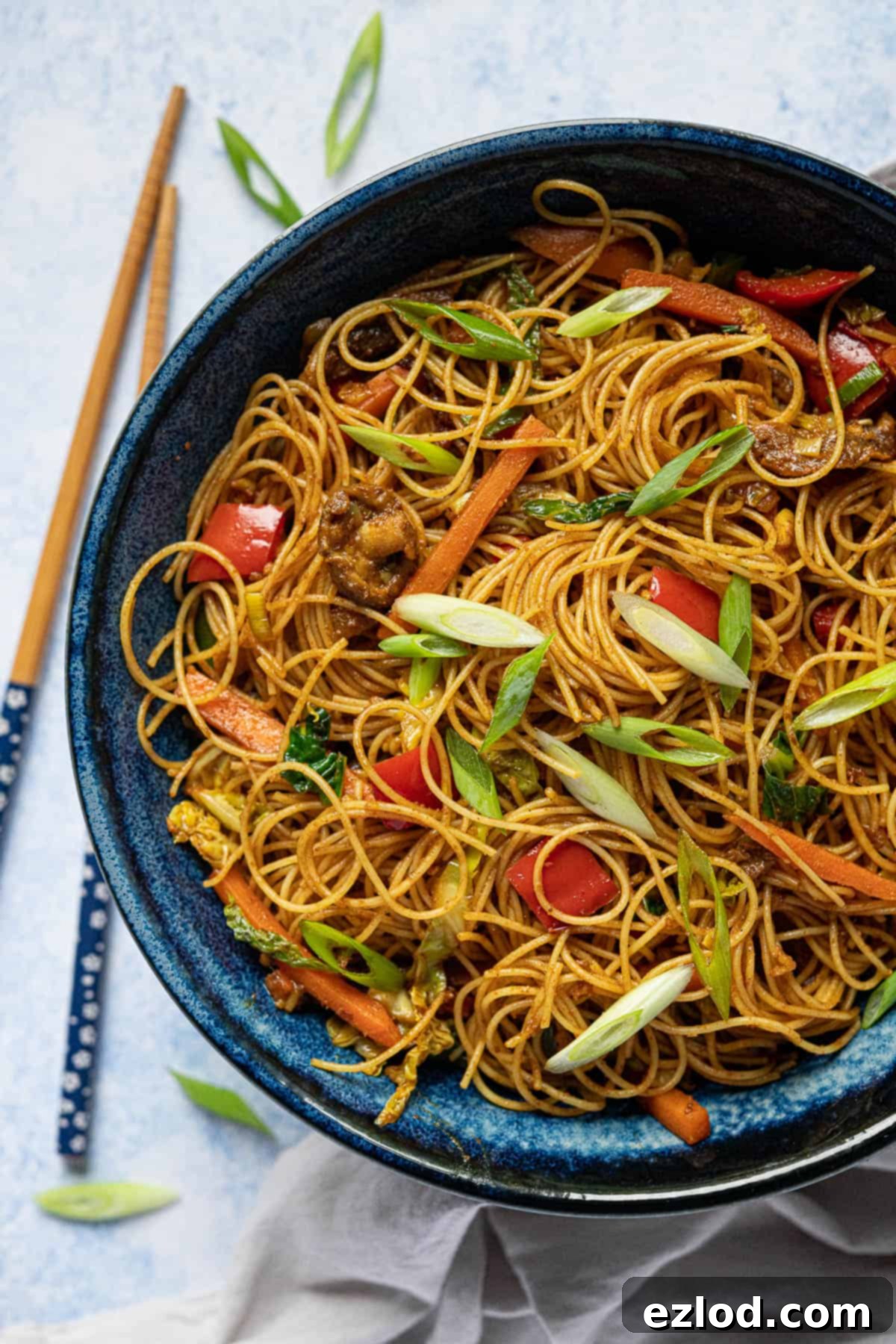
These easy vegan curry noodles offer a sensational blend of flavors and textures, proving that plant-based meals can be both incredibly satisfying and quick to prepare. Whether you’re a seasoned vegan or simply looking to incorporate more delicious plant-forward options into your diet, this recipe is sure to become a cherished favorite. Its versatility and vibrant taste make it a perfect dish for any occasion. Give it a try, and prepare to be amazed by the depth of flavor packed into every savory bite!
If you tried this recipe let me know how it went! Rate it, leave a comment or tag @domestic_gothess on Instagram and hashtag it #domesticgothess
All images and content on Domestic Gothess are copyright protected. If you want to share this recipe then please do so by using the share buttons provided. Do not screenshot or post the recipe or content in full, instead include a link to this post for the recipe.

Print
Curry Noodles (Vegan)
Ingredients
- 200 g (7 oz) rice vermicelli noodles (or noodles of your choice)
Sauce:
- 60 ml (¼ cup) light soy sauce
- 1 Tablespoon toasted sesame oil
- 1 Tablespoon grated ginger (fresh or frozen/from a jar)
- 4 cloves garlic peeled and crushed
- 1 ½ Tablespoons mild curry powder
- ½ teaspoon turmeric
- 1 teaspoon MSG
- ⅛ teaspoon white pepper
Vegetables:
- 1 small onion
- 1 red bell pepper
- 115 g (4 oz) shitakke or chestnut mushrooms
- 1 medium carrot
- 125 g (4 ½ oz) savoy cabbage
- 4 spring onions (scallions)
- 1 Tablespoon oil for frying
Instructions
-
Soak/cook the noodles according to the instructions on the packet.
-
Whisk together the soy sauce, sesame oil, ginger, garlic, curry powder, turmeric, MSG and white pepper in a jug.
-
Peel and slice the onion, cut the pepper, mushrooms and carrot into bite sized pieces, shred the cabbage and slice the spring onions.
-
Heat the oil in a large wok or frying pan over a medium high heat. Fry the onion for a couple of minutes then add the rest of the vegetables and fry over a high heat for about 3 minutes until slightly softened.
-
Add the sauce and spring onions and cook for a couple of minutes then toss through the drained noodles until they are thoroughly coated. Cook for a couple more minutes, stirring constantly, until heated through.
Notes
